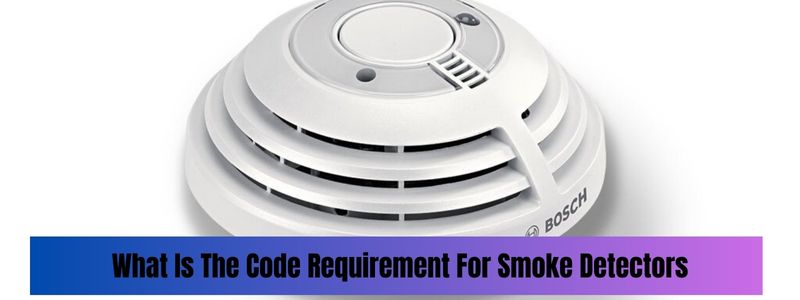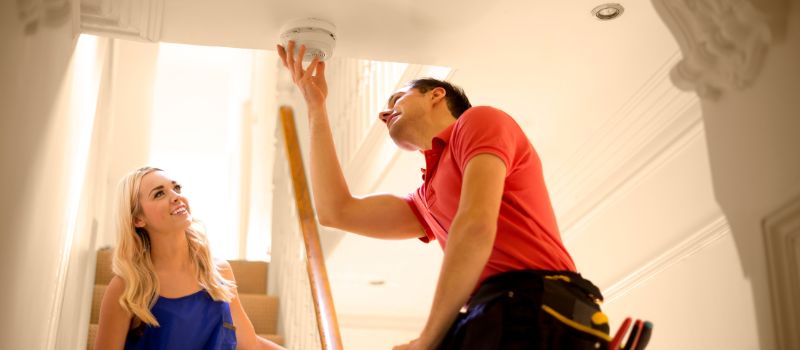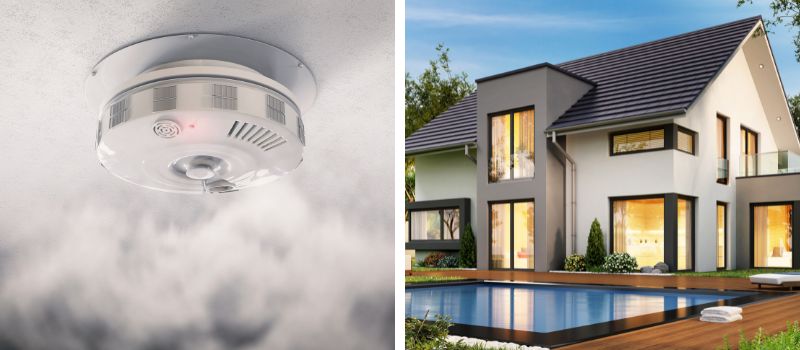Ensuring the safety of your home or workplace is of paramount importance. One essential aspect of maintaining a secure environment is installing heat detectors to alert you of possible fires. However, a common question arises: how close can a heat detector be to a wall?
In this article, we will provide expert advice on the optimal placement of heat detectors, explore the different types of detectors, and delve into the importance of following established guidelines.
How Close Can A Heat Detector Be To A Wall? My advice
The optimal distance for placing a heat detector from a wall is at least 300mm (approximately 12 inches) to ensure it is out of any ‘dead air’ spaces where airflow may be obstructed, which could negatively impact the detector’s ability to sense heat during a fire.
Below is the detailed guide on heat detector placement.
Understanding Heat Detectors
Before discussing the proximity of heat detectors to walls, it’s important to understand their purpose and how they work. Heat detectors are designed to detect a rise in temperature, which may indicate a fire. There are two main types of heat detectors: fixed temperature and rate-of-rise.
- Fixed Temperature Heat Detectors: These detectors trigger an alarm when the temperature reaches a predetermined threshold, typically around 135°F (57°C) to 190°F (88°C). They’re best suited for environments where temperature fluctuations are minimal.
- Rate-of-Rise Heat Detectors: These detectors respond to rapid increases in temperature, typically 15°F (8°C) per minute or more. They’re ideal for spaces with frequent temperature changes or in areas where a fixed temperature detector may be prone to false alarms.
Understanding the differences between these detectors is crucial when determining the appropriate type and placement for your needs.
Heat Detector Placement Guidelines
To ensure the effectiveness of your heat detectors, it’s essential to follow established guidelines for proper placement. These guidelines take into account the distance from walls, ceilings, and other structural elements to provide the best possible protection. Below, we outline the most important factors to consider when installing heat detectors.
- Distance from walls: As a general rule, heat detectors should be installed at least 4 inches (10 cm) away from walls. This helps minimize the possibility of dead air spaces, which can prevent the detector from quickly sensing heat in case of a fire.
- Ceiling height: The height of your ceiling will also impact heat detector placement. For ceilings up to 10 feet (3 meters) high, place detectors at least 4 inches (10 cm) from the wall. For ceilings between 10 and 20 feet (3-6 meters) high, increase the distance to 12-18 inches (30-46 cm). Ceilings higher than 20 feet (6 meters) may require specialized heat detectors and placement guidance from a fire protection professional.
- Spacing between detectors: Proper spacing between heat detectors is crucial for optimal coverage. The National Fire Protection Association (NFPA) recommends placing detectors no more than 30 feet (9 meters) apart, with a 15-foot (4.5 meters) radius of coverage for each detector.
- Avoid obstructions: Ensure there are no obstructions, such as large furniture, curtains, or ductwork, that may impede heat from reaching the detector. Obstructions can delay or prevent the detector from activating during a fire.
By adhering to these guidelines, you can greatly enhance the effectiveness and reliability of your heat detectors.
Importance of Following Guidelines
Ignoring established guidelines for heat detector placement can lead to disastrous consequences. Inadequate spacing, obstructions, or improper distance from walls may result in delayed or missed detection of a fire, putting lives and property at risk. By following the expert advice outlined in this article, you can ensure that your heat detectors function efficiently and provide the best possible protection.
Additional Tips for Heat Detector Installation
To further improve the safety of your home or workplace, consider the following tips for optimal heat detector installation:
- Professional installation: While you may be tempted to install heat detectors yourself, it’s always best to consult a fire protection professional. They can help you choose the right type of detector and ensure proper placement according to established guidelines.
- Regular maintenance: Heat detectors, like any safety device, require regular maintenance to remain effective. Inspect and test your detectors at least once a year, and replace the batteries as needed. If you notice any issues, such as false alarms or non-responsiveness, consult a professional immediately.
- Integration with other safety systems: Consider integrating your heat detectors with other safety systems, such as smoke detectors and fire alarm panels. This can help ensure a more comprehensive and effective fire protection plan.
- Follow manufacturer recommendations: Always follow the manufacturer’s recommendations for installation, maintenance, and testing. This will help ensure the reliability and effectiveness of your heat detectors.
Conclusion
When it comes to the safety of your home or workplace, it’s crucial to understand the importance of proper heat detector placement. Follow the above established guidelines and expert advice, you can ensure that your heat detectors are optimally positioned to provide the best possible protection against fires.
In summary, heat detectors should be installed at least 4 inches (10 cm) away from walls, with increased distance for higher ceilings. Proper spacing between detectors and avoidance of obstructions are also key factors to consider.
By adhering to these guidelines and seeking professional assistance when needed, you can have confidence in the safety and effectiveness of your heat detectors. Remember, investing in the proper placement of heat detectors is an investment in the safety and well-being of everyone in your home or workplace.
Read more about heat detectors:
- Where Should Heat Detector Be Located?
- What Is The Area Range Of A Heat Detector?
- Where Should You Not Install A Heat Detector?

Edward’s expertise in smoke detectors is particularly noteworthy. He has conducted extensive research on the latest advancements in smoke detector technology and has worked closely with manufacturers to develop cutting-edge products that can detect fires more accurately and quickly.




